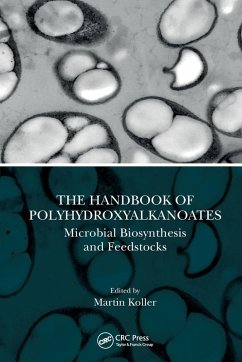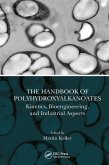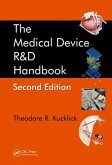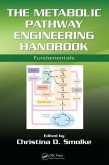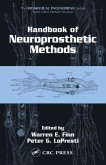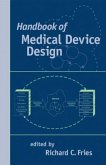The Handbook of Polyhydroxyalkanoates
Microbial Biosynthesis and Feedstocks
Herausgeber: Koller, Martin
The Handbook of Polyhydroxyalkanoates
Microbial Biosynthesis and Feedstocks
Herausgeber: Koller, Martin
- Broschiertes Buch
- Merkliste
- Auf die Merkliste
- Bewerten Bewerten
- Teilen
- Produkt teilen
- Produkterinnerung
- Produkterinnerung
This volume focuses on feedstock aspects, enzymology, metabolism and genetic engineering of PHA biosynthesis and covers mechanisms of PHA biosynthesis, enhancement of PHA biosynthesis in bio-technological and microstructure terms and performance enhancement of PHAs over established petrol-based plastics on industrial scale.
Andere Kunden interessierten sich auch für
![The Handbook of Polyhydroxyalkanoates The Handbook of Polyhydroxyalkanoates]() The Handbook of Polyhydroxyalkanoates95,99 €
The Handbook of Polyhydroxyalkanoates95,99 €![The Medical Device R&D Handbook The Medical Device R&D Handbook]() The Medical Device R&D Handbook261,99 €
The Medical Device R&D Handbook261,99 €![The Metabolic Pathway Engineering Handbook The Metabolic Pathway Engineering Handbook]() The Metabolic Pathway Engineering Handbook257,99 €
The Metabolic Pathway Engineering Handbook257,99 €![Handbook of Neuroprosthetic Methods Handbook of Neuroprosthetic Methods]() Peter G. LoPresti (ed.)Handbook of Neuroprosthetic Methods351,99 €
Peter G. LoPresti (ed.)Handbook of Neuroprosthetic Methods351,99 €![Algal Biorefineries and the Circular Bioeconomy Algal Biorefineries and the Circular Bioeconomy]() Algal Biorefineries and the Circular Bioeconomy71,99 €
Algal Biorefineries and the Circular Bioeconomy71,99 €![Handbook of Medical Device Design Handbook of Medical Device Design]() Richard C. FriesHandbook of Medical Device Design540,99 €
Richard C. FriesHandbook of Medical Device Design540,99 €![The Kinesin Superfamily Handbook The Kinesin Superfamily Handbook]() The Kinesin Superfamily Handbook83,99 €
The Kinesin Superfamily Handbook83,99 €-
-
-
This volume focuses on feedstock aspects, enzymology, metabolism and genetic engineering of PHA biosynthesis and covers mechanisms of PHA biosynthesis, enhancement of PHA biosynthesis in bio-technological and microstructure terms and performance enhancement of PHAs over established petrol-based plastics on industrial scale.
Hinweis: Dieser Artikel kann nur an eine deutsche Lieferadresse ausgeliefert werden.
Hinweis: Dieser Artikel kann nur an eine deutsche Lieferadresse ausgeliefert werden.
Produktdetails
- Produktdetails
- Verlag: CRC Press
- Seitenzahl: 454
- Erscheinungstermin: 30. August 2024
- Englisch
- Abmessung: 234mm x 156mm x 25mm
- Gewicht: 685g
- ISBN-13: 9780367541132
- ISBN-10: 0367541130
- Artikelnr.: 68711339
- Herstellerkennzeichnung
- Libri GmbH
- Europaallee 1
- 36244 Bad Hersfeld
- gpsr@libri.de
- Verlag: CRC Press
- Seitenzahl: 454
- Erscheinungstermin: 30. August 2024
- Englisch
- Abmessung: 234mm x 156mm x 25mm
- Gewicht: 685g
- ISBN-13: 9780367541132
- ISBN-10: 0367541130
- Artikelnr.: 68711339
- Herstellerkennzeichnung
- Libri GmbH
- Europaallee 1
- 36244 Bad Hersfeld
- gpsr@libri.de
Martin Koller was awarded his PhD degree by Graz University of Technology, Austria, for his thesis on polyhydroxyalkanoate (PHA) production from dairy surplus streams which was enabled by the EU-project WHEYPOL ("Dairy industry waste as source for sustainable polymeric material production"), supervised by Gerhart Braunegg, one of the most eminent PHA pioneers. As senior researcher, he worked on bio-mediated PHA production, encompassing development of continuous and discontinuous fermentation processes, and novel downstream processing techniques for sustainable PHA recovery. His research focused on cost-efficient PHA production from surplus materials by bacteria and haloarchaea and, to a minor extent, to the development for PHA for biomedical use. He currently holds more than 70 Web-of-science listed articles in high ranked scientific journals (h-index 23), authored twelve chapters in scientific books, edited three scientific books and four journal special issues on PHA, gave plenty of invited and plenary lectures at scientific conferences, and supports the editorial teams of several distinguished journals. Moreover, Martin Koller coordinated the EU-FP7 project ANIMPOL ("Biotechnological conversion of carbon containing wastes for eco-efficient production of high added value products"), which, in close cooperation between academia and industry, investigated the conversion of animal processing industry¿s waste streams towards structurally diversified PHA and follow-up products. In addition to PHA exploration, he was also active in microalgal research and in biotechnological production of various marketable compounds from renewables by yeasts, chlorophyte, bacteria, archaea, fungi or lactobacilli. At the moment, Martin Koller is active as research manager and external supervisor for PHA-related projects.
1. Monomer-Supplying Enzymes for Polyhydroxyalkanoate Biosynthesis. 2. PHA
Granule-Associated Proteins and their Diverse Functions. 3. Genomics of PHA
Synthesizing Bacteria. 4. Molecular Basis of Medium-Chain Length-PHA
Metabolism of Pseudomonas putida. 5. Production of Polyhydroxyalkanoates by
Paraburkholderia and Burkholderia species: A Journey from the Genes through
Metabolic Routes to their Biotechnological Applications. 6. Genetic
Engineering as a Tool for Enhanced PHA Biosynthesis from Inexpensive
Substrates. 7. Biosynthesis and Sequence Control of scl-PHA and mcl-PHA. 8.
Inexpensive and Waste Raw Materials for PHA Production. 9. Sustainable
Production of Polyhydroxyalkanoates from Crude Glycerol. 10. Biosynthesis
of Polyhydroxyalkanoates (PHA) from Vegetable Oils and its By-products by
Wild-Type and Recombinant Microbes. 11. Production and Modification of PHA
Polymers Produced from Long-Chain Fatty Acid. 12. Converting Petrochemical
Plastic to Biodegradable Plastic. 13. Comparing Heterotrophic with
Phototrophic PHA Production - Concurring or Complementing Strategies?. 14.
Coupling Biogas (CH4) with PHA Biosynthesis. 15. Syngas as a Sustainable
Carbon Source for PHA Production.
Granule-Associated Proteins and their Diverse Functions. 3. Genomics of PHA
Synthesizing Bacteria. 4. Molecular Basis of Medium-Chain Length-PHA
Metabolism of Pseudomonas putida. 5. Production of Polyhydroxyalkanoates by
Paraburkholderia and Burkholderia species: A Journey from the Genes through
Metabolic Routes to their Biotechnological Applications. 6. Genetic
Engineering as a Tool for Enhanced PHA Biosynthesis from Inexpensive
Substrates. 7. Biosynthesis and Sequence Control of scl-PHA and mcl-PHA. 8.
Inexpensive and Waste Raw Materials for PHA Production. 9. Sustainable
Production of Polyhydroxyalkanoates from Crude Glycerol. 10. Biosynthesis
of Polyhydroxyalkanoates (PHA) from Vegetable Oils and its By-products by
Wild-Type and Recombinant Microbes. 11. Production and Modification of PHA
Polymers Produced from Long-Chain Fatty Acid. 12. Converting Petrochemical
Plastic to Biodegradable Plastic. 13. Comparing Heterotrophic with
Phototrophic PHA Production - Concurring or Complementing Strategies?. 14.
Coupling Biogas (CH4) with PHA Biosynthesis. 15. Syngas as a Sustainable
Carbon Source for PHA Production.
1. Monomer-Supplying Enzymes for Polyhydroxyalkanoate Biosynthesis. 2. PHA
Granule-Associated Proteins and their Diverse Functions. 3. Genomics of PHA
Synthesizing Bacteria. 4. Molecular Basis of Medium-Chain Length-PHA
Metabolism of Pseudomonas putida. 5. Production of Polyhydroxyalkanoates by
Paraburkholderia and Burkholderia species: A Journey from the Genes through
Metabolic Routes to their Biotechnological Applications. 6. Genetic
Engineering as a Tool for Enhanced PHA Biosynthesis from Inexpensive
Substrates. 7. Biosynthesis and Sequence Control of scl-PHA and mcl-PHA. 8.
Inexpensive and Waste Raw Materials for PHA Production. 9. Sustainable
Production of Polyhydroxyalkanoates from Crude Glycerol. 10. Biosynthesis
of Polyhydroxyalkanoates (PHA) from Vegetable Oils and its By-products by
Wild-Type and Recombinant Microbes. 11. Production and Modification of PHA
Polymers Produced from Long-Chain Fatty Acid. 12. Converting Petrochemical
Plastic to Biodegradable Plastic. 13. Comparing Heterotrophic with
Phototrophic PHA Production - Concurring or Complementing Strategies?. 14.
Coupling Biogas (CH4) with PHA Biosynthesis. 15. Syngas as a Sustainable
Carbon Source for PHA Production.
Granule-Associated Proteins and their Diverse Functions. 3. Genomics of PHA
Synthesizing Bacteria. 4. Molecular Basis of Medium-Chain Length-PHA
Metabolism of Pseudomonas putida. 5. Production of Polyhydroxyalkanoates by
Paraburkholderia and Burkholderia species: A Journey from the Genes through
Metabolic Routes to their Biotechnological Applications. 6. Genetic
Engineering as a Tool for Enhanced PHA Biosynthesis from Inexpensive
Substrates. 7. Biosynthesis and Sequence Control of scl-PHA and mcl-PHA. 8.
Inexpensive and Waste Raw Materials for PHA Production. 9. Sustainable
Production of Polyhydroxyalkanoates from Crude Glycerol. 10. Biosynthesis
of Polyhydroxyalkanoates (PHA) from Vegetable Oils and its By-products by
Wild-Type and Recombinant Microbes. 11. Production and Modification of PHA
Polymers Produced from Long-Chain Fatty Acid. 12. Converting Petrochemical
Plastic to Biodegradable Plastic. 13. Comparing Heterotrophic with
Phototrophic PHA Production - Concurring or Complementing Strategies?. 14.
Coupling Biogas (CH4) with PHA Biosynthesis. 15. Syngas as a Sustainable
Carbon Source for PHA Production.

